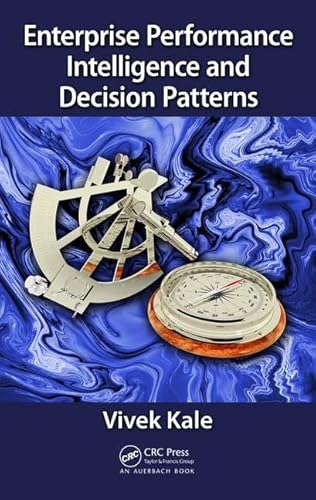Vivek Kale
Vivek Kale has more than two decades of professional IT experience during which he has handled and consulted on various aspects of enterprise-wide information modeling, enterprise architectures, business process re-design, and, e-business architectures. He has been Group CIO of Essar Group, the steel/oil & gas major of India, as well as, Raymond Ltd., the textile & apparel major of India.
He is a seasoned practitioner in enhancing business agility through digital transformation of business models, enterprise architecture and business processes, enabling the process-oriented enterprise, and, enhancing IT-enabled enterprise intelligence (EQ). He has authored books on Cloud Computing and Big Data Computing. He is also author of Agile Network Businesses: Collaboration, Coordination, and Competitive Advantage (CRC Press 2017), and, Enterprise Process Management Systems: Engineering Process-Centric Enterprise Systems using BPMN 2.0 (CRC Press 2018).
Current areas under work:
1. Digital Transformation of Enterprises: A transformation that affects exponential change (amplification or attenuation) in any aspect of enterprise performance—including enterprise architecture performance--is termed as a digital transformation. Digital transformation involves three parts effort viz. enterprise model (BM), enterprise architecture (EA) and enterprise processes (EPM). Business or enterprise model transformations played out during 2000’s with emergence of companies like Amazon, Google, Facebook, Whatsapp at the forefront of that transformation wave. But none of these would have emerged without corresponding transformations in enterprise architecture enabled by technologies like service-oriented architecture, cloud computing and big data computing. Additional EA transformations were enabled by technologies like context-Aware, Internet of Things (IoT), blockchain, soft and interactive computing. These played out with companies like Uber, Airbnb, Netflix etc.
Author’s journey for exploring the characteristics of digital transformation started with an earlier published book “Agile Network Businesses: Collaboration, Coordination, and Competitive Advantage” which is essentially a book on network and e-Business business models. The next book “Creating Smart Enterprises: Leveraging Cloud, Big Data, Web, Social Media, Mobile and IoT Technologies” detailed several technologies that are relevant for a digital transformation initiative. Author’s last book “Enterprise Process Management Systems: Engineering Process-Centric Enterprise Systems using BPMN 2.0” addresses aspects related to the digital transformation of processes.
2. Digital Transformation of Enterprise Architecture: The book proposes that like EA's traditional attributes (interoperability, scalability and availability) mobility, ubiquity, security, analyticity and usability are also attributes of EA. Therefore, digital transformation of EA (all these attributes) is affected respectively through SOA, Cloud, Big Data, context-aware, IoT, Blockchain, soft and interactive computing technologies.
3. Digital Transformation of Business Management: Management by Projects, Processes and Decisions. This book proposes that with the advent of digital economy with ever increasing demand for greater variety, at a lower cost and in shorter timeframe, business management of enterprises is, in effect, management by projects, processes and decisions.
4. Digital Transformation of Industries: The advanced digitalization within factories in combination with Internet technologies and innovations in the field of smart objects—machines and products—enabled by the ubiquitous computing are the foundations of the upcoming fourth industrial revolution (Industry 4.0 or Industrial IoT) characterized by the manufacturing strategy of mass customization.
The usage of M2M connectivity, the analysis of sensor and machine data, and a seamless communication and data exchange between individual production machines and backend systems have a huge potential to increase productivity, reduce failure, and solve quality issues.
This book unravels the mystery of IT-enabled medical, additive, nano, bio, robo, info, and cogno (MANBRIC) technology industries and explains how they can transform the operating context of their respective business enterprises and industry sectors.
5. Agile Enterprises Enterprises are confronted with two mutually contradictory challenges: the need to flexibly react to unforeseen but expected changes in the environment to continually sustain its advantage and effectiveness, as also to adapt to unexpected and radical changes in the environment to exploit new emerging opportunities. These requirements can be addresses via flexibility (VARIABILITY) and adaptability (DIGITAL TRANSFORMATION) respectively.
Popular items by Vivek Kale
View all offers-
Implementing SAP R/3: The Guide for Business and Technology Managers (Sams Professionals)
Kale, Vivek
Item prices starting from
View 3 offers£ 5.50
Also find
Used -
Guide to Cloud Computing for Business and Technology Managers: From Distributed Computing to Cloudware Applications
Kale, Vivek
Item prices starting from
View 43 offers£ 33.16
-
Business-Driven Digital Transformation: Efficiency, Scaling, and Innovation
Kale, Vivek
Item prices starting from
View 23 offers£ 23.69
-
Unleashing the Startup Unicorn: Breaking Through Constraints to the Entrepreneurial Spirit
Kale, Vivek
Item prices starting from
View 24 offers£ 23.43
-
Inverting the Paradox of Excellence: How Companies Use Variations for Business Excellence and How Enterprise Variations Are Enabled by SAP
Kale, Vivek
Item prices starting from
View 12 offers£ 43.67
Also find
New -
Agile Network Businesses: Collaboration, Coordination, and Competitive Advantage
Kale, Vivek
Item prices starting from
View 14 offers£ 38.15
-
Enterprise Performance Intelligence and Decision Patterns
Kale, Vivek
Item prices starting from
View 12 offers£ 53.51
Also find
New -
Creating Smart Enterprises: Leveraging Cloud, Big Data, Web, Social Media, Mobile and IoT Technologies
Kale, Vivek
Item prices starting from
View 26 offers£ 52.57
You've viewed 8 of 15 titles







